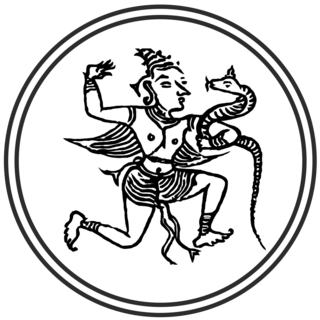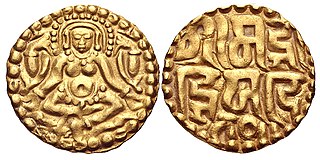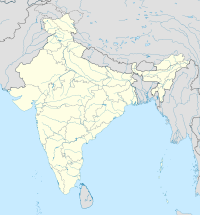
Bhoja was the Paramara Rajput ruler of the Kingdom of Malwa in central India, where his capital Dhara-nagara was located. Bhoja fought wars with nearly all his neighbours in attempts to extend his kingdom, with varying degrees of success. At its zenith, his empire extended from Chittor in the north to upper Konkan in the south, and from the Sabarmati River in the west to Vidisha in the east.

The Chandelas of Jejakabhukti was an Indian dynasty in Central India. The Chandelas ruled much of the Bundelkhand region between the 9th and the 13th centuries. They belonged to the Chandel clan of the Rajputs.
Karna I was the ruler of the Kingdom of Gujarat. He was a member of the Chaulukya dynasty and ruled from his capital Anahilapataka.

The House of Paramara is a prominent Indian Rajput dynasty that ruled over the Kingdom of Malwa, the Garhwal Kingdom, and many other kingdoms, princely states and feudal estates in North India. They belong to the Parmara clan of the Rajputs.
Udayāditya was a Paramara ruler of Malwa region of central India, who succeeded Jayasimha I. He was succeeded by his son, either Lakshmadeva or Naravarman.

The Chaulukya dynasty, also Solanki dynasty, was a dynasty that ruled the Kingdom of Gujarat in western India, between c. 940 CE and c. 1244 CE. Their capital was located at Anahilavada. At times, their rule extended to the Malwa region in present-day Madhya Pradesh. The family is also known as the "Solanki dynasty" in the vernacular literature. They belonged to the Solanki clan of Rajputs.
Jayasiṃha, who assumed the title Siddharāja, was an Indian king who ruled western parts of India. He was a member of the Chaulukya dynasty.
Munja, also known as Vakpati II, was an Indian ruler from the Paramara dynasty, who ruled the Kingdom of Malwa. He is known for consolidating the Malwa kingdom, for patronising poets and scholars and for achieving the military success against almost all of the neighbouring kingdoms.

The Kalachuris of Tripuri, also known the Kalachuris of Chedi, ruled parts of central India during 7th to 13th centuries. They are also known as the Later Kalachuris to distinguish them from their earlier namesakes, especially the Kalachuris of Mahishmati. Their core territory included the historical Chedi region, and their capital was located at Tripuri.

The 11th century Paramara king Bhoja ruled from his capital at Dhara. The period of his reign is dated approximately 1010 CE to 1055 CE, although some historians believe that he ascended the throne before 1010 CE. Bhoja inherited a kingdom centered around the Malwa region, and made several attempts to expand it varying results. He managed to annex territories as far as northern parts of Konkan, but these territorial gains were short-lived. He fought wars against several of his neighbours, including the Chaulukyas of Gujarat, the Chalukyas of Lata, the Chalukyas of Kalyani, the Chandelas of Jejakabhukti, the Kachchhapaghatas of Gwalior, the Chahamanas of Shakambhari, the Chahamanas of Naddula, and the Kalachuris of Tripuri. He also conflicted with Gaznavid Turk Invaders, Mahmud's desecration of the Somnath temple in Gujarat motivated Bhoja to lead an army against him, however after Somnath raid, Mahmud Gazhnavi chose a more dangerous route via Sindh, to avoid facing the invading powerful armies of Bhoja.
Jayasimha was the ruler of the Kingdom of Malwa in central India. He was the successor, and possibly the son, of the dynasty's most powerful king Bhoja. He appears to have ascended the throne with the support of the Kalyani Chalukya prince Vikramaditya VI, and appears to have been dethroned by Vikramaditya's rival brother Someshvara II.
Lakshmadeva was a member of the Paramara dynasty of Malwa region in central India. According to one theory, he ascended the Paramara throne after his father Udayaditya, and reigned during the 1080s CE. According to another theory, Lakshmadeva never became the king and Udayaditya was succeeded by Lakshmadeva's brother Naravarman.

Naravarman, also known as Naravarma-deva, was an Indian king from the Paramara dynasty, who ruled in the Malwa region of central India. The Paramara power greatly declined during his reign, as a result of multiple military defeats.
Jayavarman, also known as Ajayavarman, was an Indian king from the Paramara dynasty, who ruled in the Malwa region of central India. He appears to have recaptured the Paramara capital Dhara after a Chaulukya occupation of the city. Sometime later, an usurper named Ballala became the control of the city, and Jayavarman appears to have moved to a newly created principality in the Bhopal area.
The Guhilas of Medapata colloquially known as Guhilas of Mewar were a Rajput dynasty that ruled the Kingdom of Mewar region in present-day Rajasthan state of India. The Guhila kings initially ruled as Gurjara-Pratihara feudatories between the end of 8th and 9th centuries and later were independent in period of the early 10th century and allied themselves with the Rashtrakutas. Their capitals included Nagahrada (Nagda) and Aghata (Ahar). For this reason, they are also known as the Nagda-Ahar branch of the Guhilas.

Madana-Varman was a king of the Chandela dynasty of India. He succeeded his father Prithvi-Varman as the ruler of the Jejakabhukti region. He revived the Chandela glory by subduing the neighbouring kingdoms, and commissioned several tanks and temples.

Gangeyadeva was a ruler of the Kalachuri dynasty of Tripuri in central India. His kingdom was centered around the Chedi or Dahala region in present-day Madhya Pradesh.
Lakshmikarna, also known as Karna, was a ruler of the Kalachuri dynasty of Tripuri in central India. His kingdom was centered around the Chedi or Dahala region in present-day Madhya Pradesh.
Gayakarna was a ruler of the Kalachuri dynasty of Tripuri in central India. His kingdom was centered around the Chedi or Dahala region in present-day Madhya Pradesh.

The Kingdom of Gujarat was an early medieval kingdom in Western India. The kingdom was ruled by two related dynasties, the Chaulukyas and the Vaghelas, for a period of nearly four centuries and was ultimately conquered by the Delhi Sultanate as the Gujarat Province.









